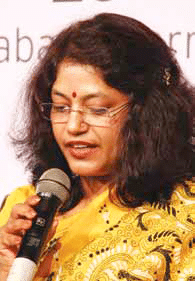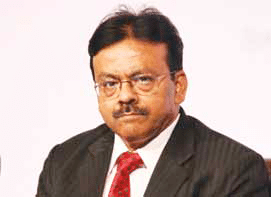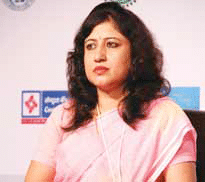 India is progressing towards building a knowledge economy and making ICTs available to all is imperative for achieving this goal. The government and private sectors are putting in dedicated and consistent efforts in this direction.Yet it is the public delivery of services that remain the ultimate benchmark of success India is progressing towards building a knowledge economy and making ICTs available to all is imperative for achieving this goal. The government and private sectors are putting in dedicated and consistent efforts in this direction.Yet it is the public delivery of services that remain the ultimate benchmark of success |
 K Sunitha, Commissioner, K Sunitha, Commissioner,Directorate of Collegiate Education,Government of Andhra PradeshIn Andhra Pradesh we have around 179 colleges are funded by government. We also have private colleges in which around 3,00,000 students studying. From our experience, we have found that the aided colleges are the best performers because they have a mix of government infrastructure, financial help as the whole faculty is funded by the government and they have autonomy in working their management and academic policies. |
 Dr Akhilesh Gupta, Secretary, Dr Akhilesh Gupta, Secretary,University Grants Commission (UGC) From 1953 to 2000, the higher education in India was growing at a slow pace. But then onwards there has been a sudden jump in the growth that was possible due to rising number of private institutions and universities. We are targeting to achieve about 25 percent GER by the end of the 12th Plan and 30 percent enrolment ratio by 2020. The enrolment ratio can be increased by the co-operation and involvement of the private sector. Our carefully planned schemes address issues related to increasing access and equity. We are trying to include the underprivileged class and communities like SC, ST, minorities, and women so that all of them get their share in higher education. We are introducing a large number of fellowships. Moreover, it is not only about the number of schemes, but also about increasing beneficiaries of each scheme. We recently started the Rajiv Gandhi fellowship for disabled students so that they also get the opportunity to pursue studies. addirWe started this Special Assistant Programme and a number of universities and colleges are participating in that. In order to bring teachers’ excellence we have set up academic staff colleges in 66 locations. We will increase that number to 100 by the end of the 12th Five-Year Plan. Currently about 450 autonomous colleges are present in the country and we will increase their numbers and provide them more autonomy and additional funds. We have launched two interesting initiatives – Joint Appointment and Student Entitlement. We are also trying to encourage teachers from universities to go and work in the research labs and the research scientist to come and teach. So, we have brought out new API norms and it is going to be helpful for many teachers in the country. We are forging several collaborations at the international level and several support systems have been created. We are bringing several institutional improvements and systemic changes, and new ICT programmes like electronic repository, etc. |
 Dr Veera Gupta, Dr Veera Gupta,Associate Professor, National University of EducationalPlanning and Administration (NUEPA)We have had a legacy of the phenomenon of divide whether that is rich or poor, digital divide or the government and private sector divide. In the first Five-Year Plan education was discussed only at the elementary level. Even then we did not talk about education for all, due to lack of resources. There was no target for secondary education and certainly none for higher education, which are part of our Five-Year Plans now. In the past decade we have aimed at universalisation of elementary as well secondary education and we have improved our GER in higher education even though it is still below the benchmarks. However, now the private sector has also started talking about the national agenda or national targets and is helping especially under the PPP mode. We also need to take up education and skill development for adults. At the government level, we need to have cohesive bodies that look after educational needs of a segment of population. For example, in the UK there is the Ministry of Young People, which is responsible for schooling or vocational training of population between 6-18 years of age. |
 Dr Nisha Mendiratta, Scientist ‘F’, Director, Climate Change Programme(CCP), Department of Science & Technology (DST)At the Department of Science and Technology we are looking at two missions – The National Mission on sustaining the Himalyan Ecosystem and the National Mission on Strategic Knowledge for Climate Change. We are trying to capture the knowledge available with all the institutions. In this the institutions and universities play a major role and we are trying to target the knowledge gap areas so that we can create a knowledge platform. Thus, this knowledge generated system should be utilised for possible policy directions, for adaptation and mitigation actions to combat the ill-effects of climate change. Dr Nisha Mendiratta, Scientist ‘F’, Director, Climate Change Programme(CCP), Department of Science & Technology (DST)At the Department of Science and Technology we are looking at two missions – The National Mission on sustaining the Himalyan Ecosystem and the National Mission on Strategic Knowledge for Climate Change. We are trying to capture the knowledge available with all the institutions. In this the institutions and universities play a major role and we are trying to target the knowledge gap areas so that we can create a knowledge platform. Thus, this knowledge generated system should be utilised for possible policy directions, for adaptation and mitigation actions to combat the ill-effects of climate change.Here the capacity building for the education sector plays a major role. We have already launched a centre in IITBombay and another one in Hyderabad. These centres are dealing with the climate change science and another one is in the area of plant protection. There are two more centres, which we have supported — Divecha Centre in Bangalore and Indo-German Centre for sustainable development at IIT-Madras. Major coordinated programmes which we have already launched include Inter- University Centre of Glaciology in which four major universities are partners. Under the Indo-Swiss capacity we want to train 25 young scientists and we may provide them a career opportunity after successful completion of this course. The National Mission for Sustaining the Himalayan Ecosystem (NMSHE) is about building and creating capacities specifically for Himalayan ecosystem and here we want to target 12 knowledge institutions for their strengthening and data collection. It is one of the important area in sharing for policy generation. So we are going to come up with a very big programme in which 25 or 50 universities, scientists, professors will be working for us to give a shape to the NMSHE deliverables |
 Prof Darlando T Khathing, Prof Darlando T Khathing,Vice Chancellor, Central University of JharkhandThe government has given a lot of autonomy to new central universities and expects us to be model universities and that’s why we are rather flexible in our approach. We are open to undertake partnerships or programmes like adjunct faculty or we can use ICT for faculty to deliver lectures, we can have joint research work or programmes. We are starting B Sc, B Ed four-year integrated programme from this year itself and it is targeted mostly for school teachers. We have also been asked by the government to start Community Colleges. We will train Class X and Class XII dropouts and enable them to come to a degree level at anytime in their life when they would like to. They can also take a break and come back after a couple of years and there is no age bar for that. |
"Exciting news! Elets technomedia is now on WhatsApp Channels Subscribe today by clicking the link and stay updated with the latest insights!" Click here!





















